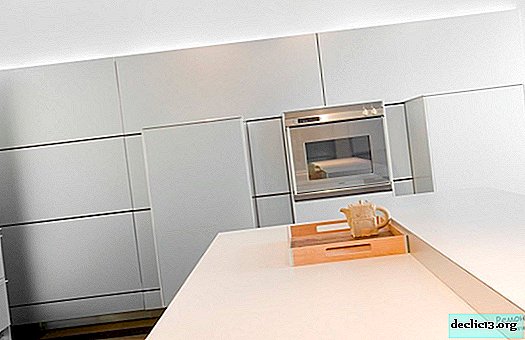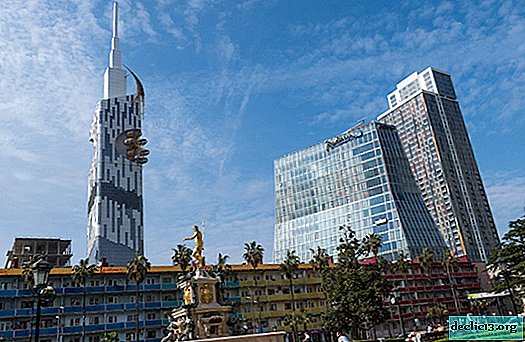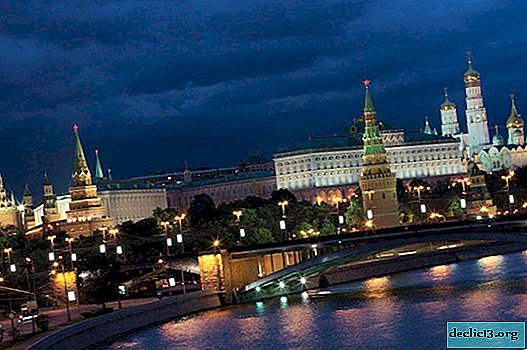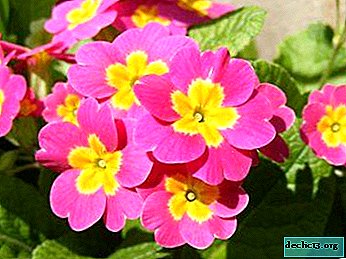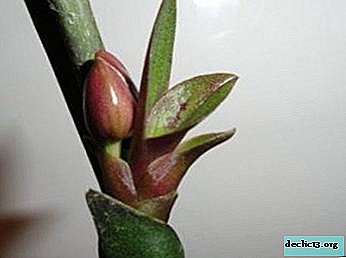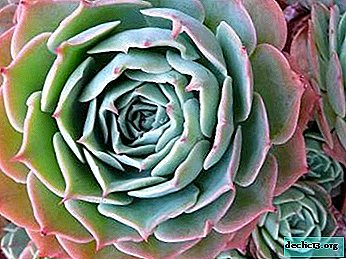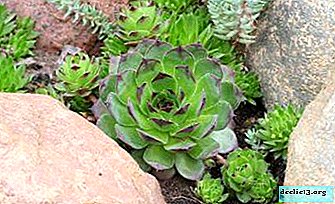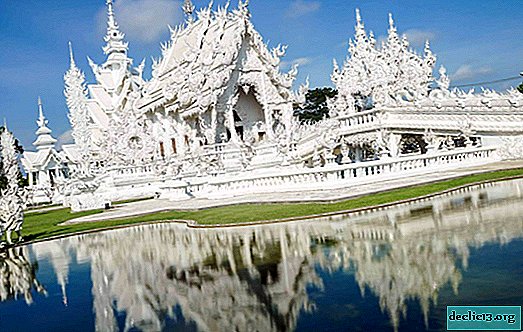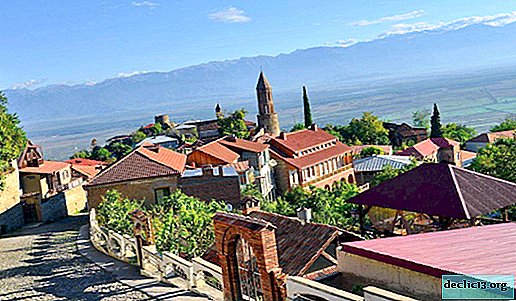Rhododendron is dense: Ramapo, Blue Tit and other varieties. Description, care features
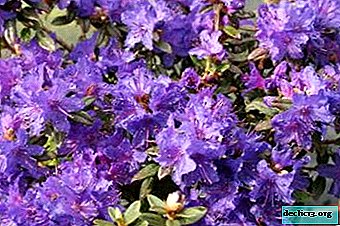
This exotic is also called confused rhododendron. It branches so densely that during flowering it forms a very dense crown - this is its exclusivity and originality.
In the article, we will talk about undersized and dwarf hybrid varieties of dense rhododendron - Azurik, Ramapo, Bluit and others, we will show their photos.
These are evergreen dense and tall shrubs with a dense crown full of flowers.
Brief definition
Rhododendron dense refers to the genus of rhododendrons of the heather family. Most often used as a decorative garden shrub. Differs in special frost resistance therefore it is in demand among gardeners. Natural varieties grow in northwest China.
Detailed description
Rhododendron is dense and its hybrid subspecies are evergreen shrubs. The height of the bush in adulthood reaches 110 - 120 cm, in diameter the bush grows by 50 - 70 cm. The crown is very dense, "stuffed" with flowers, pillow-shaped.
Shoots densely woven, highly branched, erect, sprawling. The bark is brown, rough. Young stems are thin, fragile, covered with small scales. The petiole itself is miniature, up to 3 mm, also scaly.Leaves are small, oblong, ovoid or elliptical in shape, grow no more than 1, 5 - 1, 6 cm in length and about 1 cm in width. The color of the leaves is bilateral - from above light or dark, grayish - smoky, and from the inside have a fawn shade of gray - green. Leaves are also covered with scales.
Inflorescences are few - up to 4 flowers. The root is superficial, brittle, loosening the soil is undesirable. The flowers are small, grow up to 3 cm, no more, funnel-shaped in shape. There are purple, violet - blue, lavender, there are white sub-grades. Dense rhododendron has fruits ripening in capsules in the fall.
History of occurrence
Dense rhododendron was discovered in Europe at the beginning of the 20th century. The tropical flower was introduced into the culture in 1916. The natural habitat is the open slopes of Sichuan. China also grows in alpine meadows.
Modern breeders have bred a large number of hybrid varieties that are distinguished by their special endurance and unpretentiousness in cultivation and care.
How to apply?
Dense rhododendron is used as a decorative bush for decorating flower beds, parks, alleys.
What is the difference from the rest of the species?
Rhododendron dense is characterized by good frost resistance, most hybrids do not require additional shelter for the winter, especially in snowy areas. The crown in this variety is special - pillow-shaped, voluminous, dense. The most important difference from other species - the stems and leaves are covered with miniature scales.
Description of varieties and their photos
Amethyst
Low-growing evergreen shrub 40-50 cm high. Blooms in late May - early June. The flowers are soft - lilac, light, not large, up to 3 cm in diameter. Inflorescences are formed from 3 to 5 flowers. The leaves on the inside are grayish green. Frost resistance is average, withstand up to - 24ºС in the winter.

Gristede
Evergreen undersized shrub, grows 80 - 90cm in height. The crown is dense, compact, grows in width to 1 m. It blooms in early summer. With good care, it can bloom repeatedly in the fall. The flowers are small, up to 3 cm, dark purple with a blue tint. The leaves are elongated, oval, glossy, dark green. The variety is resistant to frost, but requires mulching and shelter for the winter.

Ramapo
The Latin name for this variety of azalea is Rhododendron impeditum ramapo. A hybrid variety from America, bred in 1940. Naring. Dwarf evergreen shrub, height - 60 cm, large crown diameter - up to 2 m. The crown is flat. It blooms in early May, flowering lasts 2 to 3 weeks. The flowers are small, saturated lilac, collected in groups of 3-5 flowers. The diameter of the flower is small, up to 2.5 cm.
Lanceolate leaves, small, up to 3 cm in length and 1 - 1.5 cm wide. The structure of the leaves is leathery, shiny. Young leaves are gray - green, later acquire a bluish tint. This variety winters well under snow without shelter, but mulching is necessary.

Watch a video on how dense Rhododendron blooms:
Blue silver
The variety is called Blue Silver. Creeping shrub, branches intertwine, grows up to 90 - 100cm in height. Growing slowly. The flowers have the shape of an asterisk, at the beginning of flowering pale pink, then the petals darken, become amethyst. The flowers are small - up to 2 - 3 cm. Stamens grow in a bunch. Frost resistance is average, up to - 23 ºС in the winter.

Blue tit
Evergreen dense pillow-shaped shrub, grows up to 80 - 110 cm in height.It blooms in May, with good care, a second flowering is possible in early September. The stems are short, covered with black scales.
The leaves are small, up to 2 cm long, 1 cm wide, oblong, scaly on both sides. The flowers are small, purple with a blue tint, 2 cm in diameter. Differ in magnificent blossoming, tolerates winter well without shelter.

Azurica
A short bush, its height is only 50cm. The first flowering occurs in May, the second in August. A very dense crown grows to 1 m wide. Small bluish leaves grow to 1.5 - 2 cm in length. The flowers are dark, purple with a blue tint. Azurica's winter hardiness is very high; soil mulching required.

Billy new
The evergreen low bush has the shape of a sphere with a diameter of up to 50 cm. Flowering occurs in May, abundant. It blooms with miniature flowers, up to 1 cm in length, gently - white. The leaves are small, dense, shiny, gray - green. Frost resistance is average, dry shelter for the winter is required.

Bloom
When and how does it happen?
Flowering is generous, plentiful, occurs in May or at the very beginning of June. The crown during flowering is so dense that the leaves are almost invisible. Many hybrids with proper care can bloom repeatedly in late summer or early September.
Care Features
Dense rhododendron can be transplanted only before and after flowering. During bud formation, the temperature should be reduced to 10 - 8 ° C. After flowering, new, elongated shoots are pruned for propagation by cuttings. Old inflorescences after flowering must immediately be robbed.
What to do if it does not bloom?
- Superphosphate top dressing is used to prolong flowering and the formation of new inflorescences.
- Or the substrate is not enough minerals, you can feed fertilizers.
- It is necessary to check the bush for the presence of parasites - they stop the growth and flowering of dense rhododendrons.
- Perhaps the flowers lack moisture.
Use in landscape design
Varieties of dense rhododendron are planted along the curbs. Even after flowering takes place, garden plots stand out with lush, vibrant greenery of bushes. Look harmoniously in compositions with evergreen bushes and conifers.
Tall bushes are often planted along the walls of cottages and country houses. Designers often use exotics in the construction of alpine slides. Look good in the "company" of wild stones and boulders.Step-by-step care instructions
Choosing a place for the plant
Dense rhododendron is afraid of direct sun, it is preferable to diffused light, partial shade. Places for this species should be quiet, protected from the wind and bright sun. Balconies and loggias in summer are best done. In the garden, usually bushes are planted under the canopy of needles. In the summer, pots and drawers are taken out to the garden; they can be dug together with pots.
What should be the soil?
 The substrate should be fresh, loose, sour, moist, but not moist.
The substrate should be fresh, loose, sour, moist, but not moist.
Regularly acidify the soil through irrigation.
For planting, it is better to buy a special earthen mixture for heather plants. The composition of the substrate for dense rhododendron:
- Horse peat -2 hours.
- Coniferous or leafy land - 2 hours.
- Sand - 1h.
- Perlite to retain moisture.
It is unacceptable to add sawdust, fresh leaves, chernozem, ash to the soil.
Landing
Planting is simple, the root of a dense rhododendron is compact.
Landing is recommended in April - beginning of May or in November.
- A landing pit is excavated 50 cm deep, wide and high.
- Drainage is laid at the bottom with a layer of 10 - 15 cm.
- Planting bush is placed vertically.
- Fall asleep in advance with a prepared substrate on the root neck.
- Mulch the soil around the bush.
Temperature
Rhododendron dense loves coolness, the optimum temperature is 10 - 12 ° C. In summer, when shaded and sprayed, it can tolerate heat up to 30 ° C. The variety is frost-resistant, can withstand temperatures down to -25 ° C.
Watering
Watering for dense rhododendron requires plentiful in the summer and moderate in the fall in winter, watering is reduced by 2 times.
Important: dense rhododendron is sensitive to drought, showering or daily spraying in the summer is desirable.Water should be acidified, room temperature, peeled or rainy.
Top dressing
 Use organic fertilizers: rotted manure is bred in water 1:20, insist 2 - 3 days.
Use organic fertilizers: rotted manure is bred in water 1:20, insist 2 - 3 days.- Micronutrient fertilizer - spray the leaves.
- Intensive fertilizer - Once a week until the end of summer. Combine with watering.
- Thick rhododendron is fed with potassium and phosphorus, solution: 8g per 10 liters of water.
Fertilize in early spring to mid-summer.
Pruning
To maintain a beautiful crown shape, regular trimming of old shoots by a third is necessary. Pruning is done 3 weeks after flowering.
Transfer
The transplant is carried out in early spring, dense rhododendrons quickly adapt to new conditions.
When transplanting, the planting bush is surrounded by a rim of moss and needles, 10 cm thick.
How to prepare for winter?
Frost-resistant varieties of dense rhododendron do not require shelter. But mulching is necessary to prevent freezing of the roots.
Varieties with moderate frost resistance are best covered with burlap, girdling the bush with a rope. Remove shelter in the spring on a cloudy day.How to propagate?
Dense rhododendron is propagated mainly by cuttings:
- In the spring, when laying the kidneys, cuttings of 7-8 cm long are cut.
- Cuttings are dipped for 24 hours in a solution with a root growth stimulator.
- For rooting, they are planted in a finished special substrate to a depth of 1.5 - 2 cm.
- Seedlings take root very slowly.
Diseases and Pests
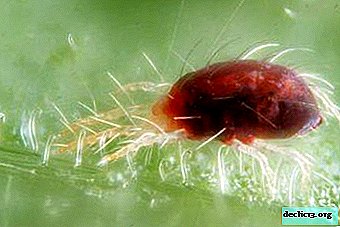 Spider mite - The most common pest of dense rhododendron, soap solution will help get rid of it.
Spider mite - The most common pest of dense rhododendron, soap solution will help get rid of it.- They attack flower and garden snails and slugs. It is necessary to collect them manually and destroy.
- From mealybug, rhododendral bug, weevil spraying with any insecticide helps - actar or phytoerm. The preventive procedure should be repeated 3 to 4 times every 8 to 10 days.
Prevention
- Problems can arise from damp soil, improperly applied fertilizers or fungi.
- Due to the sun or drying out of the substrate, the leaves may turn brown - you need to add watering.
- To get rid of rust, chlorosis, gray rot and other fungi, processing is required - watering and spraying with fungicides.
Dense rhododendron will bloom beautifully, decorating flowerbeds and home gardens Only with proper care, adequate watering and good hydration.

 Use organic fertilizers: rotted manure is bred in water 1:20, insist 2 - 3 days.
Use organic fertilizers: rotted manure is bred in water 1:20, insist 2 - 3 days. Spider mite - The most common pest of dense rhododendron, soap solution will help get rid of it.
Spider mite - The most common pest of dense rhododendron, soap solution will help get rid of it.